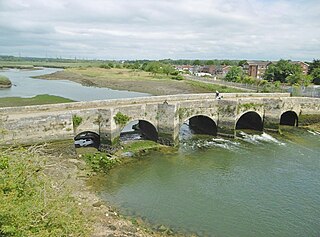
Lymington is a port town on the west bank of the Lymington River on the Solent, in the New Forest district of Hampshire, England.

New Forest is a local government district in Hampshire, England. Its council is based in Lyndhurst, although the largest town is Totton. The district also includes the towns of Fordingbridge, Lymington, New Milton and Ringwood. The district is named after and covers most of the New Forest National Park, which occupies much of the central part of the district. The main urban areas are around the periphery of the forest. The district has a coastline onto the Solent to the south and Southampton Water to the east.

The Old Town Hall was a former municipal facility at the corner of King Street and Rodney Street in Wigan, England. The building, which was demolished in September 2013, had been designated a Grade II listed building in 1990.

Croydon Town Hall is a council building in Katharine Street, Croydon which serves as the headquarters for Croydon London Borough Council. It is a Grade II listed building.

Erith Town hall is a municipal building in Walnut Tree Road, Erith, south east London. It is a locally listed building.

The old Town Hall was a municipal facility at Kensington High Street in Kensington, West London. It was demolished in 1982.

Chingford Town Hall is a municipal building in The Ridgeway, Chingford, London. It is a locally listed building.

Leyton Town Hall is a municipal building in Adelaide Road, Leyton, London. The building, which includes Leyton Great Hall, is a Grade II listed building.

Bermondsey Town Hall is a municipal building in Spa Road, Bermondsey, London. It is a Grade II listed building.

Wandsworth Town Hall is a municipal building on the corner of Wandsworth High Street and Fairfield Street in Wandsworth, London. The building, which is the headquarters of Wandsworth London Borough Council, is a Grade II listed building.

The Town Hall, Christchurch is a municipal building in Christchurch, Dorset, England. The building, which incorporates a room known as the mayor's parlour on the first floor, and is a Grade II listed building. It is currently the base of Christchurch Town Council.

The Old Town Hall is a municipal building in the High Street, Hemel Hempstead, Hertfordshire, England. The town hall, which was the meeting place of Hemel Hempstead Borough Council, is a Grade II listed building.

Folkestone Town Hall, also known as The Guildhall, is a municipal building in Guildhall Street, Folkestone, Kent, England. The town hall serves as the headquarters of Folkestone Town Council, and also houses the Folkstone Museum. It is a Grade II listed building.

Farnham Town Hall is a municipal building in South Street, Farnham, Surrey, England. It provides the offices and the meeting place of Farnham Town Council.

Godalming Borough Hall is a municipal building in Bridge Street in Godalming, England. The building was the meeting place of Godalming Town Council.

Tring Market House is a municipal building in the High Street, Tring, Hertfordshire, England. The structure, which is the meeting place of Tring Town Council, is a Grade II listed building.

The Old Town Hall is a municipal building in The High Street in Steyning, West Sussex, England. The building, which was used as a courthouse and a public events venue, is a Grade II listed building.

Hindley Town Hall, also known as Hindley Council Offices, is a municipal building in Cross Street, Hindley, Greater Manchester, England. The building is currently used by Wigan Metropolitan Borough Council for the delivery of local health and social care services.

New Milton Town Hall is a municipal building in Ashley Road in New Milton, a town in Hampshire, in England. The building accommodates the offices and meeting place of New Milton Town Council.

Petersfield Festival Hall and Town Hall is a municipal building in Heath Road in Petersfield, a town in Hampshire, in England. It hosts the annual Petersfield Musical Festival.




















